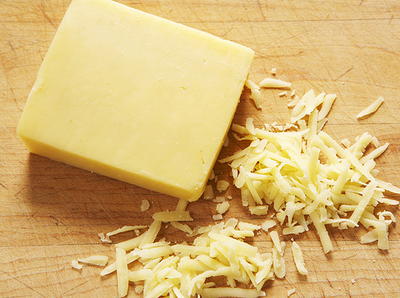
This image courtesy of Joseph DeLeo
Although this rather classic soufflé features sharp cheddar, the truth is that you can make it from almost any cheese, including Valveeta. Smoked Gouda is also a darned fine addition. Oh, and as for the Parmesan that’s used on the soufflé dish itself, that can be replaced with any cheese that’s hard enough to grate: Pecorino Romano comes to mind, as does aged Gruyere.
Serves4 to 6
OccasionCasual Dinner Party, Cooking for a date
Recipe CourseMain Course, Side Dish
Dietary ConsiderationHalal, Kosher, Peanut Free, Soy Free, Tree Nut Free, Vegetarian
Taste and TextureButtery, Cheesy, Light, Rich, Savory
Ingredients
- 43 g/1 ½ oz/3 tablespoons unsalted butter
- 21 g/¾ oz/3 tablespoons all purpose flour
- 1 teaspoon dry mustard
- ½ teaspoon garlic powder
- 1/8 teaspoon salt
- 312 g/11 oz/1 1/3 cups hot milk
- 80 g/3 oz/4 large egg yolks
- 170 g/6 oz/1 ½ cups sharp cheddar cheese, grated
- 150 g/5 oz/5 large egg whites
- 14 g/½ oz/1 tablespoon water
- ½ teaspoon cream of tartar
- 50 g/1 ¾ oz/½ cup grated Parmesan cheese (not shredded)
- Digital scale
- Wet measuring cups
- Dry measuring cups
- Measuring spoons
- Food processor
- Box grater
- Saucier or sauce pan
- Small bowl or teacup
- Stand mixer, electric mixer, or balloon whisk
- Large metal bowl (very, very clean)
- Hand mixer (also very clean)
- 1.5-quart soufflé dish
- Heavy duty plastic wrap
- Disposable pie tin
- Large rubber spatula
Instructions
-
Place an oven rack in position B (second position from the bottom) and remove any other racks from higher positions. Preheat the oven to 375°F.
-
Peel back the wrapper on the butter and, holding it like a really big lipstick, thoroughly grease the interior of the soufflé dish—be especially careful to get into the corners. Reserve the remaining butter.
-
Add the Parmesan and cover the dish tightly with plastic wrap. Shake to coat the entire interior of the dish with cheese, reserving any excess. Place the dish in the refrigerator.
-
In a small saucepan, heat the remaining butter. Allow all of the water to cook out.
-
Add the flour to the butter and whisk to combine. Reduce the heat to low and continue to cook for 2 minutes.
-
Combine the heated milk, dry mustard, garlic powder, and salt in a tightly covered container and shake well to mix. Whisk the milk mixture into the roux and return the heat to high. As soon as the mixture comes to a boil, remove the pan from the heat.
-
In another bowl, beat the egg yolks until light in color and slightly thickened. Temper the yolks into the milk mixture (see Notes), constantly whisking while doing so. Remove the pan from the heat and add the cheese. Whisk until incorporated.
-
In one more bowl, beat the egg whites, water, and cream of tartar via the Egg Foam Method, to create glossy and firm peaks.
-
Separate fresh eggs while cold, placing the whites in a clean metal bowl.
-
Using a clean balloon whisk (manned by a very stout arm) or an electric hand mixer (use a stand mixer if you must) beat the egg whiles on low speed until they are foamy.
-
Add your acid, such as cream of tartar.
-
Increase the mixer speed to high (at least 75 percent power) and move the beaters around the bowl, alternating directions.
-
Ad ¼ of the egg foam mixture to the base. Continue to add the foam by thirds, folding very gently.
-
Pour the mixture into the soufflé dish to ½ inch from the top. Place the soufflé dish in the oven on a disposable pie tin and bake for about 35 minutes, or until the soufflé has risen and is browned on top.
Notes
Tempering is a method by which beaten eggs can be intergrated into a liquid that—under any other circumstances—would be too hot for the eggs to be added to without curdling. The idea is to clowly rather than suddenly increase the temerature of the eggs.
While briskly whisking the eggs, slowly drizzle (or spoon, if it’s thick) ¼ to 1/3 of the hot mixture into the eggs, then slowly whisk this mixture into the remaining hot mixture. This will not only slow the absorption of heat by the eggs, it will ensure that the proteins are diluted with other substances and that will prevent them from reaching each other.
October 1, 2004
YOUR RECENTLY VIEWED RECIPES
We are adding your Comments. ![]()
Thank you! Your comment has been added.
We are sorry. There was an error tyring to post your rating and review.
Your comment will appear after our editors have had a chance to review it.
